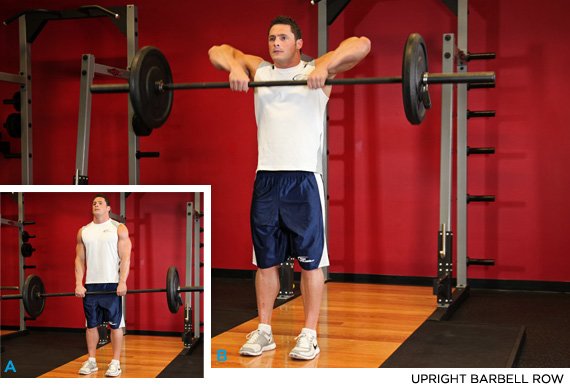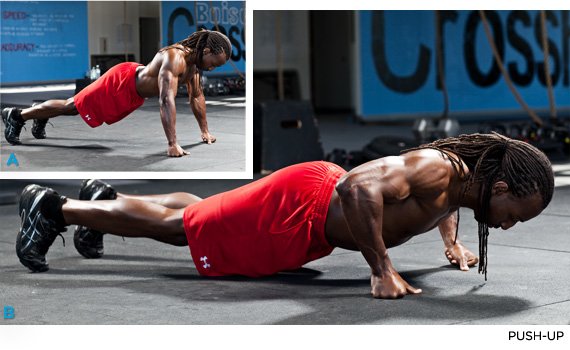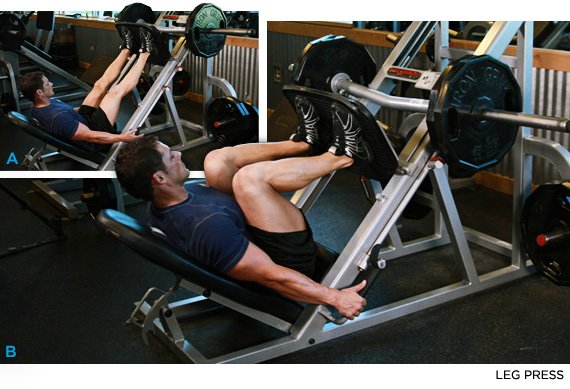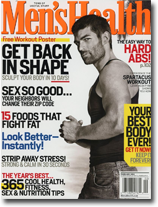Dentists hate it when you don't floss. Bartenders wince when you stumble out the door. Lawyers shake their heads when you represent yourself. After all, they know how bad the outcomes can be. So what makes a fitness pro grimace? For starters:
- When you butcher a great exercise by using poor form.
- When you use an exercise that puts you at unnecessary risk for injury.
We polled several top Men's Health advisers and asked them for specifics. The result: The top five exercises that make trainers cringe.
1 / The Classic Upright Row
Yes, this upper trap exercise is a highly popular move used by everyone from serious bodybuilders to novice lifters. But it can be murder on your shoulders. "It's my pick for the absolute worst exercise," says Mike Robertson, C.S.C.S., co-owner of Indianapolis Sports and Fitness. "It puts your shoulders in a horrible position."
That's because the exercise requires you to rotate your upper arms inward while raising them to shoulder level or above. This puts you at high risk for shoulder impingement, a painful condition in which the muscles or tendons of your rotator cuff become entrapped in your shoulder joint. We say this is one to skip entirely; there are plenty of other great exercises you can use to work your shoulders.

2 / The Typical Push-up
A well-executed pushup is a beautiful thing. It makes trainers smile and nod with respect. Trouble is, that doesn't happen often enough. "What you usually see is a person whose head is jutted forward and hips are sagging, both of which signal an underlying weakness or just poor form," says Michael Mejia, C.S.C.S., owner of B.A.S.E. Conditioning in Long Island, New York. "Your body should form a straight line from your head to your ankles."
To test your form, get into a pushup position and have someone place a broomstick or dowel rod on your back. It should touch your head, upper back, and butt, and remain in contact with all three points as you perform a pushup. Use Mejia's cues to do a pushup with perfect form.

- Brace your core. Make yourself as long as you can (stretch out!), then imagine you're about to be punched in the gut. This stiffens your torso, which helps prevent the movement of your spine. You need to hold this contraction for the duration of the exercise.
- Squeeze your glutes tightly. Then hold them this way for the entire exercise. This helps creates an inflexible bridge between your torso and legs, which keeps your hips from sagging.
- Keep your elbows tucked. As you lower your body, pull your elbows toward your rib cage instead of allowing them to flare out. This reduces stress on your shoulders.
3 / The Rounded-Back Deadlift
When we asked our top fitness experts to rank their favorite exercises, the deadlift was near the top of every list. Check that: A perfectly performed deadlift was near the top of every list. Once user-error was accounted for, the deadlift became cringe-worthy. The reason: Many people round their lower back when doing the exercise.
"It's well documented that when the lumbar spine is in a flexed or rounded position, it's more susceptible to injury," says Joe Dowdell, C.S.C.S., co-owner of Peak Performance in New York City. "And that risk increases exponentially when resistance is pulling you further into that rounded position, as it can during a deadlift."
The upshot: Don't round your lower back when you do deadlifts; it could you land you in a world of hurt. Instead, you want your spine to maintain its natural shape, with a slight arch in your lower back. Warning: You might think you aren't rounding your spine, when you actually are. Try taking a video of yourself doing the exercise and then compare your form to that in video of the deadlift below.
4 / The 45-Degree Leg Press
This is the machine in which you lie down and push the weight sled upward with your legs. It's certainly a good muscle-builder, and perhaps the most popular way that gym-goers work their legs. But when done wrong—as it often is—it can be a disaster.
"The 'easy chair' position allows people to load this up with all kinds of weight," says Mejia. "Then they round their tailbone at the bottom of the movement. This combination creates the perfect environment for a disc herniation."
Mejia's advice: If you want to build true lower body strength, stick to squats, deadlifts, lunges and step-ups. "The back support on the leg press minimizes the involvement of the core, which is why you can use more weight on it than with other lower body exercises," says Mejia. "But that also means it doesn't translate as well to sport and leisure activities, where your core is often the weakest link. What's more, it's tougher on your joints."
And from a logical perspective, you might ask yourself: Why would you lie down to work your legs?

5 / The Typical Burpee
We love the burpee. In fact, this classic calisthenic is one of the best fat-burning body-weight exercises on the planet—when it's done right.
"Unfortunately, most people lack the hip, ankle and upper back mobility to do the conventional version of this exercise safely and effectively," says B.J. Gaddour, creator of Speed Shred, the first-ever DVD fitness program from Men's Health. Common problems: "Their knees cave in as they squat, they round their lower backs, and they have little control over their bodies, leading to a high risk for injury. What's more, their form only gets worse at they fatigue."
The good news: Gaddour says that three simple adjustments can allow you to enjoy all the benefits of the burpee, while doing it safely.
- Take a wide stance. "By setting your feet significantly wider than shoulder-width apart, you'll be able to move more at the hips and less at your lower back," says Gaddour.
- Use a box. "Instead of putting your hands on the floor, place them on a low box or step to reduce your range of motion and lock in perfect form," says Gaddour. As you improve your technique and mobility, you can then move to the floor.
- Don't move too fast. "Perform the burpee more deliberately and slowly, with distinct pauses of a count or two in both the squat and push-up positions," says Gaddour. "This keeps you from getting sloppy."
Watch the video to see Gaddour demonstrate perfect burpee form in one of his Speed Shred workouts. He first shows you how to ease into a burpee by using a modified version to improve your mobility. Then he progresses into a full-on burpee that protects your back and joints while doubling as a fantastic cardio exercise.


